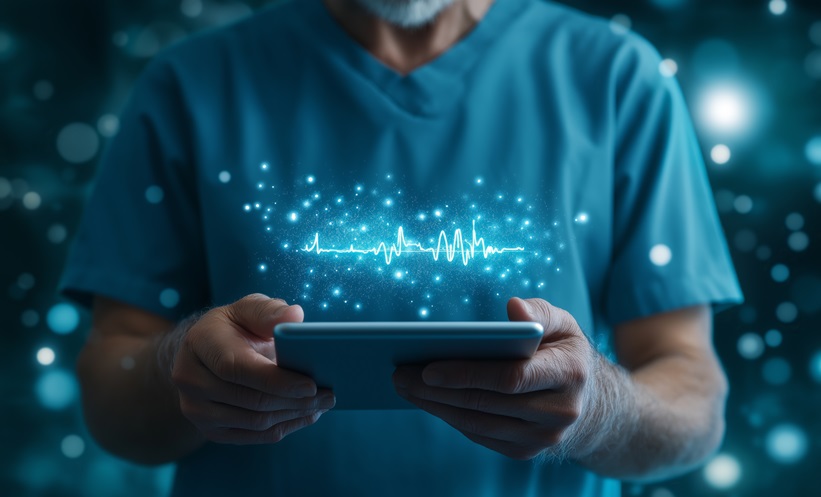Known as the most prominent event for decision-makers of the international healthcare industry, MEDICA 2018 welcomed around 120,000 visitors and >5,000 exhibitors to the jam-packed halls of the Messe Düsseldorf during 4 autumnal days in Düsseldorf, Germany. “Nowhere else in the world will you find the entire process chain of innovations for the development, manufacture, and marketing of medical devices, products, instruments, and high-tech solutions presented in such a seamless manner,” commented Wolfram Diener, CEO of Messe Düsseldorf. From laboratory products to modern treatment solutions concerning many areas of healthcare, MEDICA 2018 had something for everyone to explore and learn from. Excitement filled the exhibition halls from Day 1 of the event, not only for the innovative solutions about to be presented to transform the healthcare industry, but also for the attendance of the German Federal Minister of Health, Jens Spahn, who opened MEDICA 2018 and the 41st German Hospital Conference, which took place in parallel this year.
With the choice of themes available to attendees being as wide as ever, one of the most prominent topics of interest at this year’s event was digital transformation, known to be shaping the healthcare industry worldwide and changing both processes and business models for the better. Around 1,000 presentations were related to the digitalisation of healthcare, with a particular focus on benefits to doctors and patients. “Benefits for patients are a more efficient use of medical personnel on the one hand and easier access to specialist know-how on the other, for example, when experts from neighbouring university hospitals or even from abroad are called in virtually,” elucidated Horst Giesen, Global Portfolio Director Health & Medical Technologies at Messe Düsseldorf. MEDICA 2018 also saw the presentation of the study on Healthcare 4.0, highlighting the huge potential of digital healthcare in Germany in particular.
Topics such as big data, artificial intelligence, and cyber security were also of great interest to presenters and attendees, as they are used to tackle key issues in healthcare, from emergency medicine to chronic health conditions. The accompanying programme offered attendees numerous opportunities to experience how breath-taking advances in the development pipeline will revolutionise patient care, such as bionic technologies and overcoming phobias. The MEDICA CONNECTED HEALTH CARE FORUM and MEDICA HEALTH IT FORUM are key examples of such sessions. For those with an interest in sports medicine and fitness, there was also an array of programme highlights on offer, from corporate fitness to using sport to prevent chronic illnesses, such as diabetes. More of the key highlights from this year’s inspiring event are available throughout the EMJ Innovations Congress Review.
With development focussed towards digital health applications that are software-based, young start-up companies from across the world are taking advantage of the reduced costs of hardware development and are beginning to enter the spotlight. MEDICA 2018 provided the perfect platform to showcase just how far healthcare applications have come, with new start-up presentations given daily as part of the MEDICAL DISRUPT initiative. From applications for chronic health conditions, such as a cardiac arrythmia app, to monitoring health status with a digital stethoscope, continue reading for insights into the most recent innovations to enter the medical arena, direct from MEDICA 2018.
The 2018 MEDICA fair was once again a mammoth success, welcoming industry experts from across the world to set the scene for the next wave of care advances to be welcomed by the medical community. As the world’s largest medical trade fair, it is simply not possible to attend all sessions of interest during the 4 days, so EMJ Innovations 3.1 conveniently provides a comprehensive review of the event to keep you up-to-date. Whether you would like to refresh your memory or learn more about presentations you were unable to attend, the key data, updates, and future work can be found in the following pages, preparing you for a wonderful year of medical innovations. We look forward to welcoming you back to Düsseldorf for MEDICA 2019 to discuss these developments and encourage you all to mark the dates in your diaries: 18th–21st November 2019!

Smart Glasses Set to Take the Lead in Eye Therapy
AMBLYOPIA, or lazy eye, is a common condition in children. The historical way to treat the condition is to cover the healthy eye with a patch, thus forcing the lazy eye to work harder, correcting its function. For the patch therapy to work, the eyepatch must be worn for the prescribed period; however, this can lead to the child feeling self-conscious and refusing to wear the patch. Now, new shutter glasses developed in Germany and reported in a MEDICA press release dated 12th November 2018 could be set to revolutionise the treatment of amblyopia.
There are two major drawbacks of patch therapy: firstly, the undesirable appearance of wearing an eyepatch and, secondly, the impairment to the spatial vision of the wearer. The new glasses showcased at MEDICA 2018 have been designed to minimise both these undesirable effects of wearing a patch.
The smart glasses, developed by researchers at the Fraunhofer Institute for Biomedical Engineering IBMT, Sulzbach, Germany, have been designed to include a range of sensors integrated into the arms. The data obtained from the sensors can be viewed through a sister smartphone app and can be accessed by the ophthalmologist to monitor patient progress: “Our goal is to provide an individual, patient-based therapy,” explained Dr Frank Ihmig, Fraunhofer, IBMT. Using the data collected, the glasses, which are darkened through an electronically controlled shuttering system using integrated liquid crystals, can be adapted to each individual patient. To minimise the effects on the user’s spatial vision, the glasses remain clear during sporting activities.
The glasses offer a new, more aesthetically pleasing approach to amblyopia treatment; however, the work is by no means complete. The next step for the researchers is to reduce the size of the technology, so that it may be incorporated into the frames of a child’s glasses. Additionally, the researchers are aiming to make the technology more efficient by improving the battery life of the shutter sensors. The glasses could be a revolutionary step forward in the treatment of this common condition.
MEDICA App Competition 2018
THEY SAY seven is a magic number, and it is certainly the case that the seventh edition of the MEDICA App Competition saw some truly impressive sights. Yet the splendour on show was not sorcery but a fusion of medical science and information technology. Ten contestants reached the final round, but there could only be one winner.
The competition was for the best app-based mobile medical solution for use by a patient, doctor, or in a hospital setting. Although it culminated at MEDICA, the competition had begun many months previously. Submissions were open from June–September 2018. Out of all the submissions, a jury was then faced with the unenviable task of selecting just 10 to proceed to the final stage. Apps could not have been launched prior to the beginning of 2016 and had to be in the market by the end of quarter 1 in 2019.
There were a number of criteria these apps were judged against:
- The scalability and attractiveness of the business model.
- The quality of both the team and their provided documentation.
- The level of innovation shown by the app.
- The scale of problem-solving displayed by the app (i.e., what healthcare-related problem has it solved).
- The functionality of the app and the intuitiveness of its user interface.
The 10 contestants who presented at MEDICA were BuddyCare, FibriCheck, D-EYE 2.0, myFreescan, Medicospeaker, oPerception, Orthyo, Veta Health, Zencorlabs, and Tonic App. All had the opportunity to claim the top prize of €2,000, not to mention the healthy dose of global exposure that would follow from success on such a grand stage. All contestants delivered a 3-minute pitch, which was followed by 2 minutes of questioning from the jury. Following the conclusion of the presentations, the jury retired to make their deliberations.
After a tense waiting period, FibriCheck was deemed the winning app. This U.S. Food and Drug Administration (FDA)-approved app has been designed to use the camera on a smartphone to facilitate the detection of various cardiac arrhythmias. The app is also able to generate a report that can be accessed by doctors and/or patients.

Rehabilitation: A Patient-Centric Solution
MEDICA is a stage where many companies debut their latest offerings, with this year’s event being no different. One product taking its first steps into the medical market was the exoRehab, as reported in a MEDICA press release dated 12th November 2018. The exoRehab was developed by the South Korean robotics company Exosystems and represents the company’s first hardware development thus far.
The company’s CEO, Hooman Lee, spoke of Exosystems’ ambition to facilitate a move beyond traditional human limitations in the medical rehabilitation process. He explained how they were aiming to make rehabilitation more effective and streamlined.
This approach was borne out in the early stages of product development. Exosystems channelled the growing trend for patient centricity from the onset, seeking to identify issues faced by patients when undertaking traditional rehabilitation approaches. They determined that there were three primary issues:
- The (lack of) geographical proximity to hospitals.
- Shortages in rehabilitation services.
- Repetitive and dull movements within the rehabilitation programmes themselves.
As part of developing the exoRehab, the developers sought to ameliorate the impact of these barriers preventing patients from maximising their rehabilitation. This solutions-driven approach saw three features included as part of the exoRehab:
- Portable wearability.
- Gamification techniques incorporated into the programme. These are designed to improve patient enjoyment of the process.
- The use of artificial intelligence to gather medical data. This provides data via the cloud to medical professionals, allowing remote monitoring and thus reducing the need for hospital visits.
The exoRehab is also designed to utilise the user’s musculoskeletal data to produce individually tailored exercise and electrical stimulation programmes. As this is a newly developed project, its impact regarding uptake and efficacy remains to be fully determined.
A New HIV Test on the Block
THE EUROPEAN Centre for Disease Prevention and Control (ECDC) estimates that, in some countries, up to 43% of European HIV patients remain undiagnosed, on average 47% of individuals are diagnosed with HIV late, and 28% of patients are diagnosed with advanced HIV, which can present with AIDS-defining diseases, such a pneumonia. However, a new HIV test kit, reported in a MEDICA press release dated 12th November 2018, could be about to change the face of HIV diagnostics.
Despite increased access to HIV tests, the World Health Organization (WHO) targets of 90% of HIV patients knowing their status, 90% of those diagnosed starting antiretroviral treatment, and 90% of patients exhibiting prolonged viral suppression are still out of reach; in fact, in 2017 these figures were 75%, 79%, and 81%, respectively. Late diagnosis is believed to be a major contributing factor to the current state of HIV treatment.
The Simplitude™ Pro HIV (1&2) rapid diagnosis test, produced by Owen Mumford, Oxford, UK, includes a built-in lancet and blood collection unit. The combination allows physicians to collect blood samples and carry out the steps necessary to complete a HIV diagnosis test accurately. Tania MacKenzie, Senior Global Product Manager for Diagnostics, Owen Mumford, stated: “The introduction of the Simplitude™ Pro HIV (1&2) rapid diagnosis test at MEDICA 2018 addresses an important issue, meeting the need for a reliable point-of-care diagnostic test (the overall sensitivity and specificity is 99.6%) that is simple to use, and provides convenient and prompt results to support early diagnosis.”
The results from a recent study conducted in England and Wales showed that HIV patients diagnosed late (T cell count <350 cells/mm) were 3.5-times more likely to die than their early diagnosed counterparts. The development of the Simplitude test, through its built-in lancet and sample collection unit, could turn the tide against late HIV diagnosis, making the WHO targets increasingly more achievable.
Increasing Antibiotic Efficacy After Joint Implant Insertion
SYNERGISM between antibiotics and silver ions significantly increases the effectiveness of the drugs at preventing infection. Therefore, precisely matching the drug directly to a replaced implant, as reported in a MEDICA press release dated 12th November 2018, could reduce the risk of severe infection and implant replacement during routine hip and dental implant operations.
While implant operations are routine, they carry a risk of bacteria entering the wound and an infection occurring, requiring control with oral or intravenous antibiotics. Furthermore, in some cases, the implant may have to be removed since the pathogen cannot be eliminated. With the aim of avoiding infection altogether, research from the Synergy-Boost project, displayed at MEDICA 2018, built on the knowledge that silver ions enhance the effect of antibiotics, dependent on the drug type and the target micro-organism. Researchers from the Fraunhofer Institute for Molecular Biology and Applied Ecology (IME), Schmallenberg, Germany, performed large-scale screenings to identify effective antibiotic–silver ion combinations that could effectively eliminate pathogens and prevent implant removal. Using 20 different antibiotics with varying ratios of silver ions and 4 target pathogens, >9,000 tests were performed.
In line with standard clinical practice procedure, the scientists generated antibiograms to select antibiotics for specific pathogens using sample material. The antibiotic was then applied directly to the implant. To enhance the antibiotic’s effect, the team used a vacuum to apply a silver-containing coating to the surface of the implant, creating a structure than is able to absorb the drug. Since development of the silver coating is now complete, the Fraunhofer researchers are now working to verify its efficacy and prepare for its approval for medical devices, which could revolutionise the field and significantly increase the number of successful implant procedures. While boosting the efficacy of antibiotics at implant surfaces is greatly needed, Fraunhofer scientists are also attempting to find natural, plant-based substances from which to create new antibiotics altogether. Their first results are promising and clinical trials in this area are much anticipated.

Reaching New Athletic Heights
FASTER, HIGHER, STRONGER. Athletes around the world are pushing themselves to the limit in pursuit of these sporting goals. In the quest to reach further into the sporting stratosphere, sports science can help expand the frontiers. Prior to giving a lecture on the subject at MEDICA 2018, Prof Billy Sperlich, Julius Maximilian University of Würzburg, Würzburg, Germany, took part in an interview on point-of-care testing in high performance sports, as reported in a MEDICA press release dated 2nd November 2018.
One of the barriers athletes, especially endurance athletes, face is time; there are only so many hours in a day when one can feasibly train. It is therefore important both to make sure each hour of training is used as effectively as possible and that no hours are lost as a result of injury or excessive fatigue. Evidently, with athletes often training several times a day, detection of a possible injury or illness needs to be as swift as possible. After all, it is not much use to test for a factor, such as illness, on Monday and only receive the results on Friday, because by that point it may well be too late to take preventative action. Prof Sperlich explained: “The fact that monitoring with point-of-care testing and wearables enables prompt intervention makes this process so exciting.”
Prof Sperlich then went on to discuss the varied measurements that could be made. He noted that, for runners, markers that show immune function, muscle strain, and cardiovascular values are commonly measured. Salivary measurements are growing in frequency, as they enable measurement of stress hormones such as cortisol, testosterone, and amylase. The measurement Prof Sperlich highlighted as the most crucial was ear temperature. This marker allows for the detection of fever conditions, meaning that the training programme can be altered in response.
However, point-of-care testing faces a significant hurdle: the athletes themselves. Athletes must be motivated to undertake a high frequency of measurements. It was noted that athletes are often only keen to undergo this kind of testing once they become injured or understand that they are frequently affected by illness or injury. Nevertheless, Prof Sperlich concluded: “Since the huge advantage of point-of-care testing is that it delivers rapid test results, I expect its increased importance and rising popularity in the future.”
Virtual Spiders? Arachnophobia Therapy in the Virtual World
SPIDERS. These arachnids are a common part of everyday life for many of us, but what if the sight of a spider were debilitating? This is the reality faced by some with arachnophobia, which is estimated to affect around 3.5–6.1% of people. Arachnophobia is more than simply not wanting to hold a spider or asking someone else to move a spider away from you; indeed, upon seeing a spider, some individuals experience heart palpitations, dizziness, shivering, sweating, and shortness of breath. For some of those affected by arachnophobia, the condition has such a profound impact on their quality of life that treatment represents a necessary option.
There are two significant problems with the existing treatment options: firstly, treatment choices and facilities are scarce. If there is no treatment option in geographical proximity, it is not possible to undergo treatment. It is estimated that a lack of treatment availability has resulted in 60–80% of those with arachnophobia being unable to undergo treatment. Secondly, the most common form of treatment is, by its nature, somewhat off-putting. Typical exposure therapy can be too daunting a prospect for arachnophobes.
As a result, the DigiPhobie project has been initiated, as discussed in a MEDICA press release dated 12th November 2018. This is intended to allow patients to experience exposure therapy in a virtual environment. One of the scientists involved in the project, Dr Frank Ihmig, Fraunhofer Institute for Biomedical Engineering, Sulzbach, Germany, explained: “We transfer real exposure therapy to the digital game system that runs on the data glasses. All therapy tasks are digitally simulated. The phobia sufferer can perform various challenges, such as catching a spider with a glass and a postcard or prodding one with their finger, in virtual reality.”
During the sessions, patient parameters will be measured, and the data archived and made available for analysis. Parameters measured include variability in heart rate and breathing rate. One of the aims of this measuring is to identify specific areas of stress and thus tailor the therapy individually.
While the DigiPhobie project is an exciting prospect, data are awaited from a validation study that will commence in the spring of 2019. This study will evaluate the effectiveness of the virtual reality-based therapy.

Highlights from the MEDICA Health IT and Connected Healthcare Forums
BIG DATA, the internet of things, and artificial intelligence are of ever-growing importance in healthcare. From current diagnostics to cutting-edge innovations, the use of digital technologies is lighting the path towards a new age of treatments. The use of such technologies was scrutinised in the immensely successful MEDICA Health IT Forum and the MEDICA Connected Healthcare Forum.
A key theme across the forums was the use of artificial intelligence and robotics in healthcare. The CorTec Brian interchange ONE system was introduced on 13th November 2018; a system that connects the human nervous system with artificial intelligence allowing for stimulation and recording across 32 channels, The CorTec system has been designed to combat neurodegenerative disorders and associated symptoms. On the very next day, a deeper discussion around the use of neurostimulation and robotics was conducted, as Prof Arndt Schilling, Trauma Surgery, Orthopaedics, and Plastic Surgery, University Medical Center Göttingen, Göttingen, Germany, discussed the difficulties developers face capturing free thought in computer algorithms.
The 2018 MEDICA trade fair included specialist sessions on revolutionary smart prosthetics. Prosthetics have developed massively in the last 100 years, becoming more functional and comfortable for users; however, the work to improve this technology is not over. The focus at MEDICA 2018 turned to improving the usability of prosthetics with machine learning. The implementation of machine learning could minimise the need for patients to complete hours of training to use their prosthetics most effectively. As Prof Schilling explained, “this gives patients the pleasant feeling of the prosthetics serving them and not the other way round.”
At the cutting edge of innovation, science and technology must regularly consider the ethics of the work scientists and engineers are completing. This very subject was bridged at MEDICA 2018, making for a fascinating discussion on the question of whether everyone has the right to be provided with state-of-the-art prosthetics.
As ever, the MEDICA forums offered a glimpse of the innovations that will soon transform the way in which the medical community uses technology to achieve the best outcomes for patients.
A Focus on Start-Ups at MEDICA 2018
YOUNG companies took to the stage at this year’s MEDICA event to present solutions for treating worldwide medical conditions, from heart disease to skin cancer, as well as improving general health in everyday life. Found in the MEDICA START-UP PARK, the Wearable Technologies show, and at joint booths, >50 start-up companies presented their new telemonitoring and tracking technologies to enhance digitalisation of the healthcare industry and begin their quests for market domination.
The fast treatment and monitoring of chronic conditions was one aspect of care covered by various start-up companies at the event. StethoMe, a cordless stethoscope, was revealed as a way of enabling parents to check the function of their child’s heart and lungs at any time, reducing the number of hospital stays for children with chronic lung conditions. Optimised by artificial intelligence, the device is highly accurate and allows improvements in auscultation diagnostics and therapy monitoring. A smart inhaler application was also presented to benefit asthma patients, named FindAir ONE. The application collects inhaled medication dose information as well as detail on the environmental conditions in which the inhaler is used, allowing the patient and doctor to adjust treatment accordingly. Focussing more on heart conditions, the CellAED LifeSaver automated external defibrillator created by Rapid Response Survival can be used to indicate a heart attack via measuring heart rhythm, instructing the user on the next steps and contacting the emergency services at the same time. Also created for emergency situations, the Spektikor RAPIDA Indicator was revealed and is said to be the smallest portable heart rate indicator in the world, enabling heart rate to be established in incidents with multiple casualties.
As a condition with an increasing prevalence across the world, skin cancer was also a of focus for many start-up companies. For example, Magnosco presented their method for early detection of skin cancer using lasers to stimulate and illuminate melanin, allowing mapping of cancer cells amongst healthy cells in the skin. An algorithm is used to calculate the probability of malignant skin cancer by recording the proportion of cancer cells versus healthy cells. Available for dermatologists to use now on living and isolated tissue, this innovative approach should improve rates of early detection of skin cancer and, hence, improve survival rates.
Finally, ensuring safety and maintaining health during everyday life was shown to be important for a variety of new companies displaying their products at this year’s MEDICA event. Presentation of a technologically innovative cot sparked conversation, with details revealed on its inbuilt camera and integrated sensors to allow weight, temperature, and blood oxygen to be monitored by parents while their baby sleeps. A baby’s development can also be tracked using the image recognition technology, potentially saving the lives of children who require additional monitoring. Furthermore, LogonU is focussed on adult health, applying scientific analysis for numerous physical activities to define a level of health. From measuring muscle activity in real time to detecting poor technique, the smart tracking application, reported as an ‘everyday hero’ at MEDICA 2018, can be applied to sport and healthcare.
Providing an insight into the latest start-up companies from the field of innovations, it was clear from MEDICA 2018 that digitalisation within the healthcare industry is a trend worldwide and will continue for years to come. From enhancing the care of patients with serious illnesses to improving wellbeing during everyday activities, the start-ups presented at this year’s event offered an array of innovative solutions. To round-off the start-up programme, experts explored how these start-ups can successfully enter the market and overcome the associated challenges, using examples from others that have successfully passed the first roadblocks.








